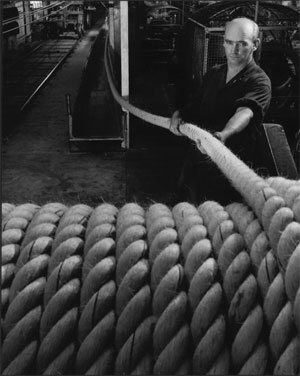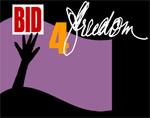From Julian Burnside:
Wolfgang Sievers came to Australia in 1938, a refugee from Germany. He became the pre-eminent industrial and architectural photographer in Australia. His work is visually marvellous, and his driving spirit was the dignity of man.
Wolfgang Sievers gave me all his remaining photographs to sell for the benefit of any human rights causes I choose. It is a 5-10 year project.
There are some magnificent images, all printed and signed by him. In total there are over 250 photographs. If you want to see a comprehensive collection of Wolfgang's work, go to the National Library of Australia (click!)
He was keen that the sale of his remaining photographs should benefit human rights causes in Australia.
The article below appeared in 'The Age' and 'Sydney Morning Herald'.
Titan's lens and moral compass enlightened all
David Zuker and Barry Jones
'The Age' August 17, 2007
PHOTOGRAPHER
18-9-1913 - 7-8-2007
 |
| Ropemaking, Miller Rope, Melbourne (1962) |
WOLFGANG Sievers, one of the world's great industrial and architectural photographers, and a passionate campaigner for human rights, has died in Linacre Hospital in Hampton. He was 93.
Sievers served as a volunteer in the Australian Army from 1942 and became an Australian citizen in 1944, the first German to be naturalised after the outbreak of World War II in September 1939.
His father, Johannes Sievers, a distinguished art historian, worked as a senior bureaucrat in the German Foreign Office until the Nazis took power in 1933. He wrote an important four-volume study on the neo-classical architect Karl Friedrich Schinkel, with photographs by his son. Siever's mother, Herma Schiffer, a teacher and art theorist, was Jewish, and Wolfgang always felt that she willed herself to die, just before Hitler became Reich chancellor. Under the Nuremberg Laws, the young Sievers, who claimed German, Dutch, Jewish and French ancestry, was classified as non-Aryan. He planned to become an archaeologist, but the racial laws disqualified him.
Largely self-taught as a photographer, he lived in Portugal from 1934 to 1935 and his early work was commemorated by a retrospective exhibition in Lisbon in 1999. He returned to Germany in 1936, and studied at the Contempora School for Modern Applied Arts (a successor to the Bauhaus), and also taught there briefly. He left Germany in June 1938 and by October had set up as a photographer in Melbourne, attracting influential patrons such as Maie Casey.
Unmatched as an industrial photographer, he also specialised in landscape, streetscape, architecture and genre scenes. He took very few portraits.
His contemporaries in photography were Max Dupain, Helmut Newton and Athol Shmith. He accused Dupain of "body fascism", for his adulation of perfect physique, and he broke with Newton, too, considering him lacking in personal generosity, but retained a lifelong friendship with Shmith.
In 1988 he declined an invitation to join Dupain, David Moore and three other artists to photograph New Parliament House in Canberra, because he detested the structure. "The building lacks the purity of design which arises from a sustained concept, and is repeatedly marred by 'featurism' - that besetting sin of Australian architecture," he wrote. "The task of a responsible photographer is not to discover some bits and pieces or some interesting perspectives but to interpret a great work of art in his own way ... My conscience will not allow me to have any part in it . . . That means keeping faith with my spiritual inheritance for which I left my native country."
While never a household name, despite the familiarity of his iconic images of manufacturing processes, buildings, mines, landscapes and archaeological exhibits, Sievers won critical acclaim with the touring exhibition The Life and Work of Wolfgang Sievers (1991), curated by the Australian National Gallery, and Film Australia's Photographers of Australia (1992), devoted to Dupain, Sievers and Moore.
His favourite image was Ropemaking, Miller Rope, Melbourne (1962) because it emphasised the dignity of labour and the role of the worker. His Gears for mining industry, Vickers Ruwolt, Burnley, Melbourne (1967) was commemorated on a postage stamp in 1991. He linked the familiar with the unexpected and produce a profound result.
He claimed in his Who's Who in Australia entry to have been "instrumental in changing the image of Australia as a country of wheat and wool to one of industry, craftsmen and scientific achievements". It is a fair claim. He also wrote: "Never forgetting what I owe my parents; justice and tolerance of all people whatever colour or faith, to help people, archaeology and arts, reading, classical music, loving the beautiful world man has not yet been able to destroy, objector to all warmongers ..."
Life Line, the photography of Wolfgang Sievers, by Jorge Calado, was published in Lisbon in English and Portuguese (Linha de Vida) in 2000, and there was also a retrospective exhibition of his work in Berlin. He was created an Officer in the Order of Australia in 2002.
Sievers never thought of himself as anything special. He enjoyed talking to students of photography and other photographers, but his greater joy was recounting his experiences to the young. When he told young people about his experiences, they sat wide-eyed and engrossed in what he had to tell them. Here was living history talking to them.
Sievers was fiercely Australian and never took for granted the freedoms he found here; he loved the multicultural society. His later life was dedicated to helping the under-privileged and dispossessed.
Sievers' social conscience wasn't shaped just by 1930s Germany. While photographing for the mining industry in the Northern Territory he became acutely aware of the plight of Aborigines and of the desperate conditions many of them lived in. Deeply moved by visiting an Aboriginal community run by women in Central Australia, he supported their work in education and health, in part recognition for the freedom he had to live on their land.
His desire, even compulsion, to help was universal. Amnesty International and Medecins Sans Frontieres were beneficiaries of his generosity. Last year he gave all his remaining photographs to Julian Burnside, QC, to be sold to benefit human rights causes generally.
Sievers described himself as "born to see". It is a fitting epitaph.
He married Brita Klaerich, a Finn, in 1939 and they divorced in 1972. His daughter Karin survives him. A son, Anders, died in 1991.
